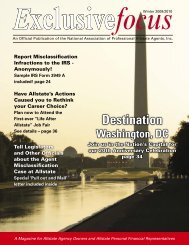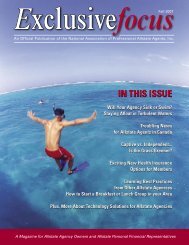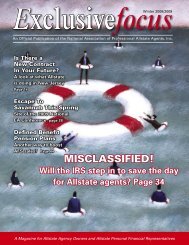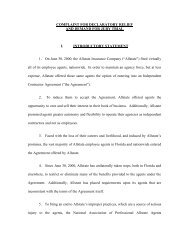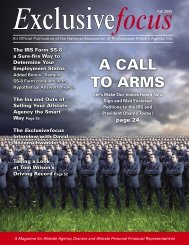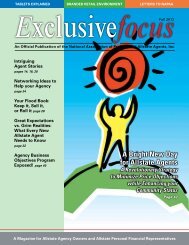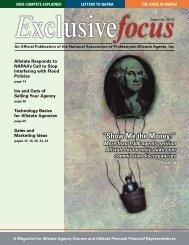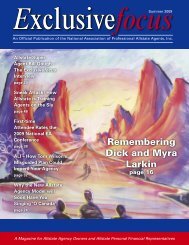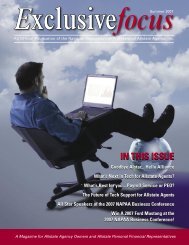Exclusivefocus Spring 2013 - National Association of Professional ...
Exclusivefocus Spring 2013 - National Association of Professional ...
Exclusivefocus Spring 2013 - National Association of Professional ...
Create successful ePaper yourself
Turn your PDF publications into a flip-book with our unique Google optimized e-Paper software.
piece away before opening the envelope.<br />
Avoid company-approved mailings<br />
and co-op opportunities. For the most<br />
part, these mail pieces are designed and<br />
witten to drive business to the company,<br />
not necessarily to your agency. Therefore,<br />
your objective should be to create a<br />
piece that makes the customer think your<br />
agency <strong>of</strong>fers something that they’re not<br />
going to get through another agency.<br />
Maybe it’s the quote that you’ve included<br />
in your mailer, or the the superior customer<br />
service that comes with being a<br />
customer <strong>of</strong> your agency. The biggest<br />
reason you want to avoid co-op mailings<br />
is because <strong>of</strong> their cookie cutter appearance<br />
– they almost always look like<br />
junk mail and are filled with disclaimers.<br />
Have you ever noticed the fine print at<br />
the bottom <strong>of</strong> a co-op letter Most <strong>of</strong> it<br />
goes along with footnotes in the text <strong>of</strong><br />
the letter and deals with exclusions, legal<br />
notices, etc. While they may be wellmeaning,<br />
but they look like one thing – a<br />
junk mail advertisement.<br />
As a recipient <strong>of</strong> these one-size-fits-all<br />
insurance mailings, I am disappointed by<br />
the lack <strong>of</strong> originality in them. Unfortunately,<br />
these mailings reveal something<br />
about the agents who send them out. I<br />
know an Allstate customer who – because<br />
<strong>of</strong> the mass agent firings in recent<br />
years – has three different Allstate agents<br />
and all <strong>of</strong> them send him the same bland<br />
letter on his birthday. He doesn’t even<br />
open them anymore because the letters<br />
are the same every year.<br />
This same problem happens when<br />
multiple agents solicit the same Zip Code<br />
using company-approved mail pieces. In<br />
instances like this, it is common for prospects<br />
to receive the exact same solicitation<br />
from each agent. There is absolutely<br />
NOTHING personal about form letters<br />
that look like advertisements. Many recipients<br />
simply throw them away, wasting<br />
the agent’s hard-earned marketing<br />
dollars.<br />
Co-op mailings <strong>of</strong>ten include your signature<br />
in the closing <strong>of</strong> the letter. At some<br />
point, you signed a camera card allowing<br />
the company to digitize your signature<br />
and use it on various documents, including<br />
co-op mailings. Unfortunately, it looks<br />
like a digitized signature and it’s blatantly<br />
obvious that you didn’t sign the letter. A<br />
properly targeted direct mail campaign<br />
includes letters that are actually signed by<br />
you. Your actual signature on a letter says<br />
a lot about you. It says that the content <strong>of</strong><br />
the letter is something that is specifically<br />
meant for the recipient. It also says to the<br />
people receiving the mailing that they are<br />
important to you.<br />
The time it takes to sign each letter<br />
in blue ink is a good investment <strong>of</strong> your<br />
time because it tells the prospect that<br />
what they’re reading is personal. A real<br />
blue-ink signature will never be confused<br />
with the artificial black-ink signature<br />
found on co-op form letters.<br />
I know there are those who will disagree,<br />
but I don’t recommend using bulk<br />
mail or putting postage on envelopes<br />
with a postal machine. Instead, use a<br />
first-class stamp. Does this make your<br />
mailing more expensive Yes, it does, but<br />
it significantly increases the likelihood<br />
<strong>of</strong> the envelope being opened. I would<br />
much prefer having each <strong>of</strong> my individually<br />
stamped envelopes opened and pay<br />
the associated postage than save a few<br />
dollars and have 6 out <strong>of</strong> 10 envelopes<br />
thrown away unopened. At that rate, you<br />
would have to nearly double the number<br />
<strong>of</strong> letters in your mailing – significantly<br />
increasing your postage costs – to get the<br />
same response as your first-class mailing.<br />
I call this working smarter, not harder.<br />
Do you know the difference between<br />
First-Class Mail, Express Mail, Priority<br />
Mail, Certified Mail and Registered<br />
Mail Many people don’t and that can be<br />
used to your benefit. With all <strong>of</strong> the options<br />
available when you go to the post<br />
<strong>of</strong>fice, it can be easy for people to confuse<br />
First-Class Mail with Priority Mail<br />
and mistakenly believe that anything<br />
sent first-class is special or otherwise important.<br />
If you put a stamp on a letter<br />
and drop it in the mail it will be sent via<br />
First-Class Mail. There is nothing that<br />
says you can’t include the words “First-<br />
Class Mail” on the face <strong>of</strong> the envelope.<br />
Since it’s going to go first-class whether<br />
you specify so or not, I recommend you<br />
invest in a self-inking red stamp that says<br />
“First-Class Mail” and that you stamp it<br />
on the envelope to the left <strong>of</strong> the address<br />
<strong>of</strong> the recipient. Why Because it looks<br />
more important, and since many people<br />
associate “First-Class” with something<br />
above and beyond normal mail, their first<br />
inclination is to open the envelope when<br />
they receive it.<br />
One final trick is to include a photo <strong>of</strong><br />
something that belongs to the customer<br />
on the envelope. I used to take photos <strong>of</strong><br />
contractors’ work trucks when I was out<br />
and about and would send them a letter<br />
about commercial auto insurance. In the<br />
lower left corner <strong>of</strong> the envelope I would<br />
print the photo on the envelope along<br />
with a line <strong>of</strong> text that read, “Important<br />
Information Enclosed.” This increased<br />
the amount <strong>of</strong> time it took to print the<br />
envelopes, but after setting up a special<br />
template, all I had to do was drop the<br />
photo into the template and hit print.<br />
If you’re sending a mailing about homeowners<br />
insurance, many county assessment<br />
websites include photos <strong>of</strong> houses<br />
on the parcel’s webpage. It is almost<br />
guaranteed that when someone receives<br />
a letter with a photo <strong>of</strong> their house or vehicle<br />
on the front <strong>of</strong> the envelope they<br />
will open the letter – you can’t get more<br />
personal than this!<br />
Hopefully, you will now agree that<br />
what many consider to be one <strong>of</strong> the<br />
worst ways to advertise may actually<br />
be one <strong>of</strong> the best, especially if you put<br />
some thought into who your prospects<br />
are, what your envelope and letter look<br />
like and the timing <strong>of</strong> when you send it.<br />
Targeted direct mail is more complicated<br />
than just stuffing envelopes and sending<br />
out mass mailings. Finding the right target<br />
audience and sending personalized<br />
and meaningful correspondence to them<br />
at a time when they are most likely to<br />
act on it, will open the door to increased<br />
sales. Then, when they respond to your<br />
letter – and you will be pleasantly surprised<br />
at how many will – make sure that<br />
when all is said and done, you have taken<br />
every opportunity to cross-sell every line<br />
<strong>of</strong> insurance they need and you’ll be well<br />
on your way to growing your book! Ef<br />
Scott Brodbeck is a Micros<strong>of</strong>t Certified<br />
Systems Engineer and a Master Certified<br />
Novell Engineer who is also a former<br />
EA and IA. Currently he develops technical<br />
marketing tools and provides marketing<br />
consulting services specializing in the pr<strong>of</strong>itable<br />
growth <strong>of</strong> insurance agencies. He can be<br />
reached via email at scott@scottbrodbeck.<br />
36 — <strong>Exclusivefocus</strong> <strong>Spring</strong> <strong>2013</strong>



